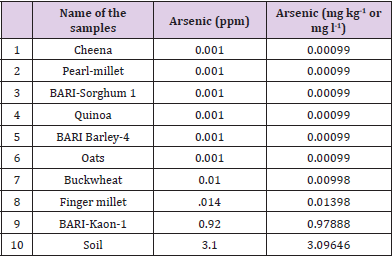Determination of Arsenic in Minor Cereals (Barley, Foxtail Millet, Proso-Millet, Finger- Millet, Pearl -Millet, Buckwheat, Oat, Quinoa and Sorghum) in Gazipur, Bangladesh
Introduction
Cereals are a staple food for many people around the world including Bangladesh; however, they are also a major dietary source of toxic arsenic (As). Most agricultural lands of Bangladesh are contaminated with arsenic (59 out of 64 districts are arsenic contaminated according to IAEA [1] which can be accumulated to high levels in the grains of cereals cultivated in these regions, posing serious health risks to consumers. Arsenic has two forms such as trivalent (ASIII) and pentavalent (AsV), thus it has larger atomic radius, more electron clouds, relative higher reaction affinity (ASIII) to thiol group/sulfhydryl group (-SH) groups than other divalent cations Most and Papenbrock [2]. As such this notorious heavy metal being efficiently absorbed in skin, lung, kidney, liver, and bladder than any other heavy metals. Though, the level of arsenic contamination and its consequence has been well studied in rice, however, a similar study has not been performed in other cereals (like wheat, maize, barley, and foxtail millet, etc.) despite their increasing trend of production and end-use. Hence, to save the nation, it is imperative to develop cereals that will contain reduced levels of arsenic. Genetic engineering strategies could be employed to develop a variety that will retain a lower amount of toxic arsenic. Therefore, the level of arsenic in the existing cereals has to be determined as a starting point towards lower arsenic variety development. Thus, the arsenic content in the minor cereals available in PBD and grown in Joydebpur soil (Barley, Foxtail millet, Proso-millet, Finger-millet, Pearl-millet, Buckwheat, Oat, Quinoa, and BARI–Sorghum 1) were determined in this experiment. The primary arsenic status of these cereals may have given clues for designing the appropriate breeding program in the future.
Materials and Methods
The leaves of available nine kinds minor of cereal (Barley, Foxtail millet, Proso-millet, Finger- millet, Pearl-millet, Buckwheat, Oat, Quinoa, and BARI–Sorghum 1) were collected from Joydebpur experimental field to their total arsenic accumulation. Before elemental analysis, the leaves samples were oven-dried at a constant temperature of 65°C for 10 days. Subsequently, dried leaves were grounded into fine powder for arsenic level determination. Simultaneously, a soil sample from the same location was collected and subjected to arsenic level determination. The elemental analysis was performed by the soil science division of BARI.
Results and Discussion
The chemical analysis of nine kinds of cereal has shown arsenic accumulation in their leaves in (Table 1). The unit value of arsenic was expressed in ppm (mg l-1 or mg kg-1). The table depicted that total arsenic accumulation of all the minor cereals was remaining an acceptable limit (1-920 μg kg-1). The acceptable limit of arsenic in the terrestrial plant was determined less than 10 mg kg-1 under normal conditions (Matschullat, 2000). Several plants contain arsenic in the following order: cabbage (0.020 – 0.050 mg kg-1) < carrots (0.040 – 0.080) < grass (0.020 – 0.160) < potatoes (0.020- 0.200) < lettuce (0.020 – 0.250) < mosses and lichens (0.26) < ferns (1.3) Matschullat [3]. Comparing the arsenic content in the abovementioned crops with the nine minor kinds of cereal of PBD, all the cereals have shown a negligible amount of arsenic. Although it has been shown that BARI Kaon-1 contains an increasing amount of arsenic comparing with others, it holds arsenic an acceptable limit; because, an average toxicity threshold of 40 mg kg-1was established for crop plants Sheppard [4]. The soil-arsenic analysis was shown 3 mg kg-1which is also negligible that indicates corresponding sites are not contaminated by arsenic. According to Adriano [5], soilarsenic concentration typically varies from below 10 mg kg-1 in noncontaminated soils to as high as 30,000 mg kg-1 in contaminated soils Vaughan [6]. So, it is pragmatic when the soil has less amount of arsenic and crop grown in that particular soil must have less amount of arsenic. In the current experimental condition, it is not possible to say that the crops have less capacity for arsenic accumulation. It could possible they can extract higher arsenic in contaminated soil.
Conclusion
The cereals grown in Joydeppur’s experimental field have shown non-contamination by arsenic. Therefore, it can be said that seeds produced in Joydebpur experimental field and distributed to farmers and other organizations are free of arsenic. Safe food consumption is not only significant for human but also require for other animals, therefore, ensuring safe food for all kind of lives is one of the objectives of sustainable development goal-2 (SDG- 2). The biochemical analysis needs to be extended for crops that are growing in arsenic-contaminated sites, typically Chandpur, Munshiganj, Gopalganj, Madaripur, Noakhali, Satkhira, Comilla, Meherpur, Bagerhat and Khulna region which are the high arseniccontaminated zone. In addition, similar analysis can be carried out in control conditions where crops will be subjected to varying concentrations of arsenic. The expected output could help to developing an arsenic resistance crop.
For more Articles on: https://biomedres01.blogspot.com/



No comments:
Post a Comment
Note: Only a member of this blog may post a comment.